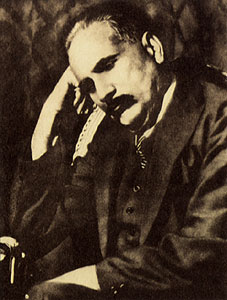Related Research Articles

Hindi cinema, popularly known as Bollywood and formerly as Bombay cinema, refers to the film industry based in Mumbai, engaged in production of motion pictures in Hindi language. The popular term Bollywood is a portmanteau of "Bombay" and "Hollywood". The industry is a part of the larger Indian cinema, which also includes South Indian cinema and other smaller film industries.

Modern Standard Hindi, commonly referred to as Hindi, is an Indo-Aryan language spoken chiefly in North India, and serves as the lingua franca of the Hindi Belt region encompassing parts of northern, central, eastern, and western India. Hindi has been described as a standardised and Sanskritised register of the Hindustani language, which itself is based primarily on the Khariboli dialect of Delhi and neighbouring areas of North India. Hindi, written in the Devanagari script, is one of the two official languages of the Government of India, along with English. It is an official language in nine states and three union territories and an additional official language in three other states. Hindi is also one of the 22 scheduled languages of the Republic of India.

Urdu is an Indo-Aryan language spoken chiefly in South Asia. It is the national language and lingua franca of Pakistan, where it is also an official language alongside English. In India, Urdu is an Eighth Schedule language whose status and cultural heritage is recognised by the Constitution of India; and it also has an official status in several Indian states. In Nepal, Urdu is a registered regional dialect and in South Africa it is a protected language in the constitution. It is also spoken as a minority language in Afghanistan and Bangladesh, with no official status.

Hindustani is an Indo-Aryan language spoken in Deccan, Northern India and Pakistan, and used as a lingua franca in both countries. Hindustani is a pluricentric language with two standard registers, known as Hindi and Urdu. Thus, it is also called Hindi–Urdu. Colloquial registers of the language fall on a spectrum between these standards. In modern times, a third variety of Hindustani with significant English influences has also appeared which is sometimes called Hinglish.

Desi is a loose term used to describe the people, cultures, and products of the Indian subcontinent and their diaspora, derived from Sanskrit देश (deśá), meaning "land, country". Desi traces its origin to the Indo-Aryan speakers from the South Asian republics of India, Pakistan and Bangladesh, and may also sometimes include people from Sri Lanka, the Maldives, Nepal and Bhutan.

Lollywood is Pakistan's film industry, which has served as the base for both Urdu- and Punjabi-language film production.

"Sare Jahan se Accha", formally known as "Tarānah-e-Hindi", is an Urdu language patriotic song for children written by poet Allama Muhammad Iqbal in the ghazal style of Urdu poetry. The poem was published in the weekly journal Ittehad on 16 August 1904. Publicly recited by Iqbal the following year at Government College, Lahore, British India it quickly became an anthem of opposition to the British Raj. The song, an ode to Hindustan—the land comprising present-day Bangladesh, India and Pakistan, was later published in 1924 in the Urdu book Bang-i-Dara.

Asian Television Network (ATN) is a publicly traded Canadian broadcasting company, with 54 television channels in 9 languages, serving the South Asian cultural communities in Canada. ATN operates a South Asian Radio service on XM, available in Canada and the United States. Headquartered in Markham, Ontario, the company has been in operation since 1997, and is headed by Indo-Canadian broadcaster Shan Chandrasekar.
Hindustani is one of the predominant languages of South Asia, with federal status in the republics of India and Pakistan in its standardized forms of Hindi and Urdu respectively. It is widely spoken and understood as a second language in Nepal, Bangladesh, and the Persian Gulf and as such is considered a lingua franca in the northern Indian subcontinent. It is also one of the most widely spoken languages in the world by total number of speakers. It developed in north India, principally during the Mughal Empire, when the Persian language exerted a strong influence on the Western Hindi languages of central India; this contact between the Hindu and Muslim cultures resulted in the core Indo-Aryan vocabulary of the Indian dialect of Hindi spoken in Delhi, whose earliest form is known as Old Hindi, being enriched with Persian loanwords. Rekhta, or "mixed" speech, which came to be known as Hindustani, Hindi, Hindavi, and Urdu, also locally known as Lashkari or Lashkari Zaban in long form, was thus created. This form was elevated to the status of a literary language, and after the partition of colonial India and independence this collection of dialects became the basis for modern standard Hindi and Urdu. Although these official languages are distinct registers with regards to their formal aspects, such as modern technical vocabulary, they continue to be all but indistinguishable in their vernacular form. From the colonial era onwards, Hindustani has also taken in many words from English, with an urban English-influenced variety emerging known as Hinglish.

The Culture of Pakistan is based in the Indo-Persian cultural matrix that constitutes a foundation plank of South Asian Muslim identity. The region has formed a distinct cultural unit within the main cultural complex of South Asia, Middle East and Central Asia. There are differences in culture among the different ethnic groups in matters such as dress, food, and religion, especially where pre-Islamic customs differ from Islamic practices.
The Persian language and Urdu have had an intricate relationship throughout the history of the latter. Persian historically played a significant role in the formation and development of the modern Urdu, and today acts as its prestige language.

Kofta is a family of meatball or meatloaf dishes found in Balkan, Middle Eastern, North African, South Caucasian, South Asian and Central Asian cuisines. In the simplest form, koftas consist of balls of minced meat – usually beef, chicken, pork, lamb or mutton, or a mixture – mixed with spices and sometimes other ingredients. The earliest known recipes are found in early Arab cookbooks and call for ground lamb.

The Hindi–Urdu controversy arose in 19th century colonial India out of the debate over whether Modern Standard Hindi or Standard Urdu should be chosen as a national language.

The Urdu movement was a socio-political movement aimed at making the Urdu standard of the Hindostani language as the universal lingua-franca and symbol of the cultural and political identity of the Muslim communities of the Indian subcontinent during the British Raj. The movement began with the fall of the Mughal Empire in the mid-19th century, fuelled by the Aligarh movement of Sir Syed Ahmed Khan. It strongly influenced the All India Muslim League and the Pakistan movement.

Tailoring is a profession which is done by the people of different religions and communities of the world for their livelihood or as business in modern times. Talking about the old times, the tailoring business can be seen among the communities. In the Indian tradition, it was customary to wrap it over the body rather than wearing it. Nowadays wrap clothes tradition is limited. Most of the people prefer to wear stitched clothes.
Tariq Rahman is a Pakistani academic scholar, newspaper columnist, researcher, and a writer.

Islam in Uttar Pradesh is the second largest religion in the state with 38,483,967 adherents in 2011, forming 19.26% of the total population. Muslims of Uttar Pradesh have also been referred to as Hindustani Musalman. They do not form a unified ethnic community, but are differentiated by sectarian and Baradari divisions, as well as by language and geography. Nevertheless, the community shares some unifying cultural factors. Uttar Pradesh has more Muslims than any Muslim-majority country in the world except Indonesia, Pakistan, Bangladesh, Nigeria, Egypt, Iran and Turkey.

Shalwar kameez is a traditional combination dress worn by women, and in some regions by men, in South Asia, and Central Asia.
Muhajir culture is the culture of the various Muslims of different ethnicities who migrated mainly from North India in 1947 generally to Karachi, the federal capital of Pakistan and before 1947 Karachi is the capital of Sindh. They consist of various ethnicities and linguistic groups. The Muhajirs are mainly concentrated in Karachi and Hyderabad.
References
- ↑ Report of the Backward Classes Commission. Government of India. 1983. p. 48.
- ↑ South Asian Language Review, Volumes 3-4. Creative Publishers. 1993. p. 67.
dArzi:(means 'tailor' in Hindi-Urdu) Darzi
- ↑ The Migration Process: Capital, Gifts and Offerings among British Pakistanis by Pnina Werbner Berg publications